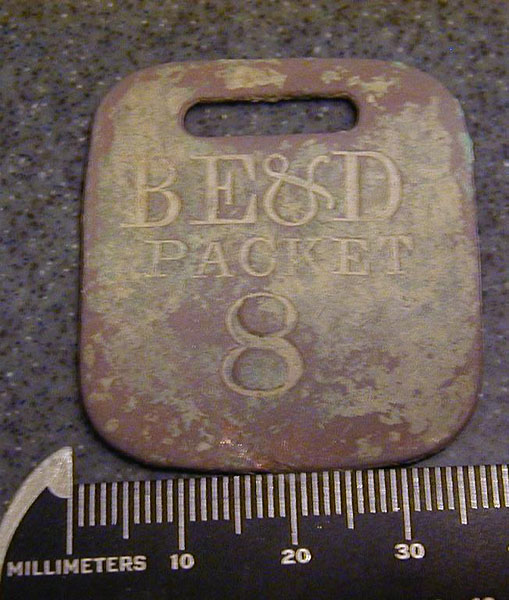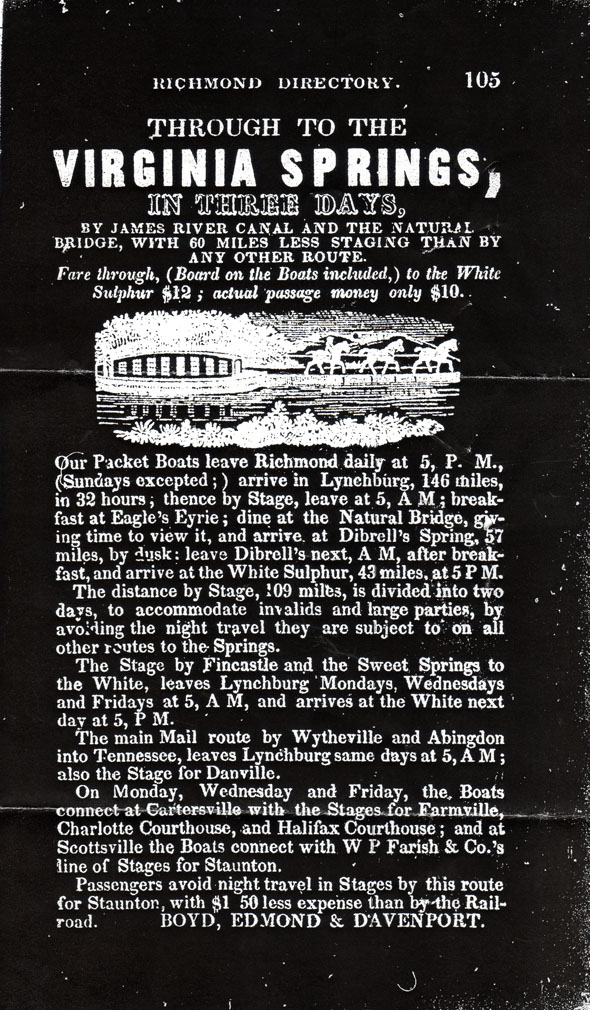

  |
|

|
Name: Boyd, Edmond, and Davenport Packet Boats Date: ca. 1842 Image Number: JH563cdJH30 Comments: Scottsvillian Jack Hamner, an experienced 'dirt fisherman' (relic hunter), unearthed this packet boat baggage tag near an old stone chimney between Keene and Esmont. The tag's front reads "BE&D Packet, 8." Engraved on the tag's back is "John Robbins, Boston." In the mid-1800's, such small metal tags were attached to a traveler's personal luggage and usually bore the name of the issuing party (hotel, railroad or other transportation company) along with a number by which a passenger could identify his or her luggage. At the end of one's hotel stay or upon arrival at the desired destination, these tags usually were removed and returned to the issuing company for reuse. For whatever reason, this tag was not returned to the packet boat company operating on the James River and Kanawha Canal that passes through Scottsville. Instead this tag ended up seven or eight miles from the Canal between Keene and Esmont, Virginia, perhaps accompanying the passenger's bag to his home. The BE&D initials on this baggage tag stand for the initials of Boyd, Edmond, and Davenport, the dominant packet (passenger) boat company on the James River and Kanawha Canal which was organized in March 1842. BE&D ran a line of light packet boats that carried passengers and mail between Richmond and Lynchburg. Two of these packet boats, the Joseph C. Cabell and the John Marshall, made three trips weekly each way. The overnight trip took about thirty-five hours at a speed of four miles per hour. Fares charged were $8.00 each way, including meals. Passengers boarded at the company's Richmond basin at 8 AM on Mondays, Wednesdays, and Fridays. The boats arrived at Scottsville at 1 AM the next morning and at Lynchburg at 7 PM that evening, a trip lasting thirty-five hours. Because of the slight current in the canal, the return trip took 2 hours less. Scottsville was an important destination, particularly in the summer because of the exodus from the dangerously unhealthy cities to the clean air and purgative waters of the mountain spas. There, seventy-nine miles upriver, passengers off-loaded into stagecoaches, which took them over Rockfish Gap, through Staunton, and on to White Sulphur, Warm and Hot Springs, and to other resorts. Here is a 1845 BE&D ad in the Richmond Directory, explaining the advantages of traveling on their packet boats west towards Scottsville and Lynchburg and transferring to stagecoaches to the Springs:  Copyright © 2018 by Scottsville Museum References: |
|
|
|
Museum
Archive
Business
Cemeteries
Church
Events
Floods
For Kids
Homes
Portraits
Postcards
School
Transportation
Civil War WWII Esmont Search Policy |
||||
|
Scottsville Museum · 290 Main Street · Scottsville, Virginia 24590 · 434-286-2247 www.avenue.org/smuseum · info@scottsvillemuseum.com Copyright © 2018 by Scottsville Museum |
||||